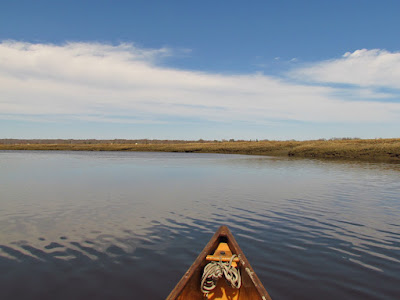We set out from the sea, and if you follow this stuff, you know that I either start at the sea or up in the forest at Foot Bridge. But, the tide is high today, just high enough to maybe lick the tires of my car at the launch. And, a high tide opens up the route possibilities in the salt marsh.
We head up the Neck, and then into Bailey Creek. Osprey are all around as usual for this time of year. Several of the nests must have eggs as one of each pair remains down in the nest within only the head showing. Willets and Yellow-Legs are all around as well and we have a conversation about the differences and habits. Fortunately I boned up on the subject last night.
 |
| Just coming to Pocket-Knife Corner on the way back. |
When we get to the narrower sections of the marsh I point out how the Willets are absent but the Yellow Legs are still there. We find a mature Bald Eagle in the usual spot for a mature Bald Eagle, in a tall tree overlooking the lowest bend of the Big Bends.
It's not far after that, near the arch bridge, that the marsh changes from spartina to cattail, a sign of the water changing from brackish to fresh. Spartina thrives in salt water and cattails dominate in fresh (spartina can grow in fresh, but it can't compete with other plants).
A second Eagle is flushed from a tree as we paddle into the forest.
Then, we begin to talk about art...we always end up talking about art.
We turn around at the Foote Bridge and ride the beginning of an ebb flow. It rains lightly, it is not the least bit unpleasant. Red Wing Blackbirds are being busy in this part of the river.
We retrace our route and watch and listen to birds. The temperature drops and it begins to rain hard just as we are taking the canoe out. Timing is everything.



































